YOKOGAWA PH402G User's Manual
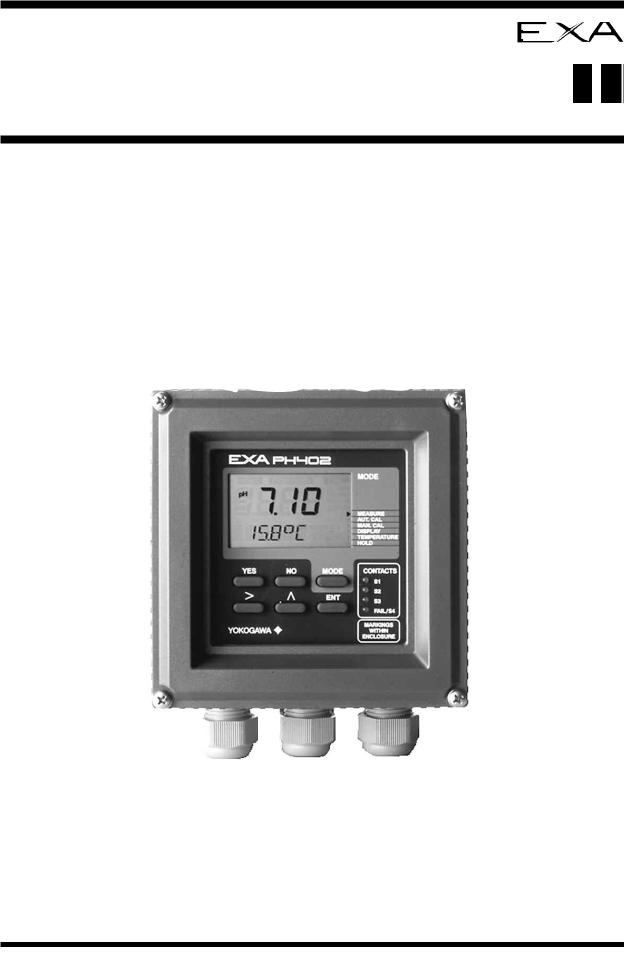
Instruction
Manual
Model PH402G
pH Converter
YOKOGAWA 
IM 12B6B3-E-E 8th Edition
|
TABLE OF CONTENTS |
|
PREFACE |
|
|
1. INTRODUCTION AND GENERAL DESCRIPTION . . . . . . . . . . . . . . . . . . . . . . . . . . . . . . . . . . . |
1-1 |
|
1-1. |
Instrument check . . . . . . . . . . . . . . . . . . . . . . . . . . . . . . . . . . . . . . . . . . . . . . . . . . . . . . . . |
.1-1 |
1-2. |
Application . . . . . . . . . . . . . . . . . . . . . . . . . . . . . . . . . . . . . . . . . . . . . . . . . . . . . . . . . . |
1-2 |
2. PH402 SPECIFICATIONS . . . . . . . . . . . . . . . . . . . . . . . . . . . . . . . . . . . . . . . . . . . . . . . . . . . . . . .2-1 2-1. General . . . . . . . . . . . . . . . . . . . . . . . . . . . . . . . . . . . . . . . . . . . . . . . . . . . . . . . . . .2-1 2-2. Operating specifications . . . . . . . . . . . . . . . . . . . . . . . . . . . . . . . . . . . . . . . . . . . . . . . . . . . . . .2-2 2-3. Model and suffix codes . . . . . . . . . . . . . . . . . . . . . . . . . . . . . . . . . . . . . . . . . . . . . . . . . . . . . .2-2
3. INSTALLATION AND WIRING . . . . . . . . . . . . . . . . . . . . . . . . . . . . . . . . . . . . . . . . . . . . . . |
. . . . .3-1 |
3-1. Installation and dimensions . . . . . . . . . . . . . . . . . . . . . . . . . . . . . . . . . . . . . . . . . . . . . . |
. . . . .3-1 |
3-1-1. Installation site . . . . . . . . . . . . . . . . . . . . . . . . . . . . . . . . . . . . . . . . . . . . . . . . . . . . |
. . . . .3-1 |
3-1-2. Mounting methods . . . . . . . . . . . . . . . . . . . . . . . . . . . . . . . . . . . . . . . . . . . . . . . . |
. . . . .3-1 |
3-2. Preparation . . . . . . . . . . . . . . . . . . . . . . . . . . . . . . . . . . . . . . . . . . . . . . . . . . . . . |
. . . . .3-3 |
3-3. Wiring the power supply . . . . . . . . . . . . . . . . . . . . . . . . . . . . . . . . . . . . . . . . . . . . . . . . |
. . . . .3-4 |
3-3-1. General precautions . . . . . . . . . . . . . . . . . . . . . . . . . . . . . . . . . . . . . . . . . . . . . . . |
. . . . .3-4 |
3-3-2. Access to terminal and cable entry . . . . . . . . . . . . . . . . . . . . . . . . . . . . . . . . . . . . |
. . . . .3-4 |
3-3-3. AC power . . . . . . . . . . . . . . . . . . . . . . . . . . . . . . . . . . . . . . . . . . . . . . . . . . . . . |
. . . . .3-5 |
3-3-4. DC power . . . . . . . . . . . . . . . . . . . . . . . . . . . . . . . . . . . . . . . . . . . . . . . . . . . . . |
. . . . .3-5 |
3-3-5. Grounding the housing . . . . . . . . . . . . . . . . . . . . . . . . . . . . . . . . . . . . . . . . . . . . . |
. . . . .3-5 |
3-3-6. Switching on the instrument . . . . . . . . . . . . . . . . . . . . . . . . . . . . . . . . . . . . . . . . . |
. . . . .3-5 |
3-4. Wiring the contact signals . . . . . . . . . . . . . . . . . . . . . . . . . . . . . . . . . . . . . . . . . . . . . . . |
. . . . .3-6 |
3-4-1. General precautions . . . . . . . . . . . . . . . . . . . . . . . . . . . . . . . . . . . . . . . . . . . . . . . |
. . . . .3-6 |
3-4-2. Contact outputs . . . . . . . . . . . . . . . . . . . . . . . . . . . . . . . . . . . . . . . . . . . . . . . . . . |
. . . . .3-6 |
3-5. Wiring the analog output signals . . . . . . . . . . . . . . . . . . . . . . . . . . . . . . . . . . . . . . . . . . |
. . . . .3-6 |
3-5-1. General precautions . . . . . . . . . . . . . . . . . . . . . . . . . . . . . . . . . . . . . . . . . . . . . . . |
. . . . .3-6 |
3-5-2. Analog output signals . . . . . . . . . . . . . . . . . . . . . . . . . . . . . . . . . . . . . . . . . . . . . . |
. . . . .3-6 |
3-6. Wiring the sensor system . . . . . . . . . . . . . . . . . . . . . . . . . . . . . . . . . . . . . . . . . . . . . . . . |
. . . . .3-7 |
3-6-1. Impedance measurement jumper settings . . . . . . . . . . . . . . . . . . . . . . . . . . . . . . . |
. . . . .3-7 |
3-7. Sensor wiring . . . . . . . . . . . . . . . . . . . . . . . . . . . . . . . . . . . . . . . . . . . . . . . . . . . . . |
. . . .3-10 |
3-7-1. Connection cable . . . . . . . . . . . . . . . . . . . . . . . . . . . . . . . . . . . . . . . . . . . . . . . . . |
. . . .3-11 |
3-7-2. Sensor cable connection with special grommet . . . . . . . . . . . . . . . . . . . . . . . . . . |
. . . .3-12 |
3-7-3. Sensor cable connections using junction box (BA10) and extension cable (WF10) |
. . . .3-13 |
3-8. Tag plate mounting . . . . . . . . . . . . . . . . . . . . . . . . . . . . . . . . . . . . . . . . . . . . . . . . . . . . |
. . . .3-15 |
4. OPERATION; DISPLAY FUNCTIONS AND SETTING . . . . . . . . . . . . . . . . . . . . . . . . . . . . |
. . . . .4-1 |
4-1. Operator interface . . . . . . . . . . . . . . . . . . . . . . . . . . . . . . . . . . . . . . . . . . . . . . . . . . . . . |
. . . . .4-1 |
4-2. Explanation of operating keys . . . . . . . . . . . . . . . . . . . . . . . . . . . . . . . . . . . . . . . . . . . . |
. . . . .4-2 |
4-3. Setting passcodes . . . . . . . . . . . . . . . . . . . . . . . . . . . . . . . . . . . . . . . . . . . . . . . . . . . . . |
. . . . .4-3 |
4-3-1. Passcode protection . . . . . . . . . . . . . . . . . . . . . . . . . . . . . . . . . . . . . . . . . . . . . . . |
. . . . .4-3 |
4-4. Display examples . . . . . . . . . . . . . . . . . . . . . . . . . . . . . . . . . . . . . . . . . . . . . . . . . . . . . |
. . . . .4-3 |
4-5. Display functions . . . . . . . . . . . . . . . . . . . . . . . . . . . . . . . . . . . . . . . . . . . . . . . . . . . . . |
. . . . .4-4 |
4-5-1. Display functions pH (default) . . . . . . . . . . . . . . . . . . . . . . . . . . . . . . . . . . . . . . . . |
. . . . .4-4 |
4-5-2. Display functions pH (ORP) . . . . . . . . . . . . . . . . . . . . . . . . . . . . . . . . . . . . . . . . . . |
. . . . .4-5 |
4-5-3. Display functions pH (rH) . . . . . . . . . . . . . . . . . . . . . . . . . . . . . . . . . . . . . . . . . . . . |
. . . . .4-6 |
5. PARAMETER SETTING . . . . . . . . . . . . . . . . . . . . . . . . . . . . . . . . . . . . . . . . . . . . . . . . . . . . . . . .5-1 5-1. Maintenance mode . . . . . . . . . . . . . . . . . . . . . . . . . . . . . . . . . . . . . . . . . . . . . . . . . . . . . . . . .5-2 5-1-1. Manual temperature selection and adjustment . . . . . . . . . . . . . . . . . . . . . . . . . . . . . . . .5-3 5-1-2. Process temperature measuring in ORP mode . . . . . . . . . . . . . . . . . . . . . . . . . . . . . . . .5-4 5-1-3. Manual activation of HOLD . . . . . . . . . . . . . . . . . . . . . . . . . . . . . . . . . . . . . . . . . . . . . . .5-4 5-1-4. Manual wash start/stop . . . . . . . . . . . . . . . . . . . . . . . . . . . . . . . . . . . . . . . . . . . . . . . . . .5-5
IM 12B6B3-E-E
5-1-5. Setpoint adjustment . . . . . . . . . . . . . . . . . . . . . . . . . . . . . . . . . . . . . . . . . . . . . . . . . . |
. .5-6 |
5-1-6. Manual impedance check . . . . . . . . . . . . . . . . . . . . . . . . . . . . . . . . . . . . . . . . . . . . . . . |
.5-7 |
5-2. Commissioning mode . . . . . . . . . . . . . . . . . . . . . . . . . . . . . . . . . . . . . . . . . . . . . . . . . . . . . . . . . |
.5-8 |
5-2-1. Setpoints . . . . . . . . . . . . . . . . . . . . . . . . . . . . . . . . . . . . . . . . . . . . . . . . . . . . . . . . . |
.5-9 |
5-2-2. Range . . . . . . . . . . . . . . . . . . . . . . . . . . . . . . . . . . . . . . . . . . . . . . . . . . . . . . . . . |
5-11 |
5-2-3. Hold . . . . . . . . . . . . . . . . . . . . . . . . . . . . . . . . . . . . . . . . . . . . . . . . . . . . . . . . . |
5-13 |
5-2-4. Wash . . . . . . . . . . . . . . . . . . . . . . . . . . . . . . . . . . . . . . . . . . . . . . . . . . . . . . . . . |
5-15 |
5-2-5. Service . . . . . . . . . . . . . . . . . . . . . . . . . . . . . . . . . . . . . . . . . . . . . . . . . . . . . . . . . |
5-16 |
5-3. Notes for guidance in the use of service coded settings . . . . . . . . . . . . . . . . . . . . . . . . . . . . . . . |
5-17 |
5-3-1. Parameter specific functions . . . . . . . . . . . . . . . . . . . . . . . . . . . . . . . . . . . . . . . . . . . . . |
5-18 |
5-3-2. Temperature compensation and measuring functions . . . . . . . . . . . . . . . . . . . . . . . . . . |
5-20 |
5-3-3. Calibration functions . . . . . . . . . . . . . . . . . . . . . . . . . . . . . . . . . . . . . . . . . . . . . . . . . . . |
5-22 |
5-3-4. mA Output functions . . . . . . . . . . . . . . . . . . . . . . . . . . . . . . . . . . . . . . . . . . . . . . . . . . . |
5-24 |
5-3-5. Contact outputs . . . . . . . . . . . . . . . . . . . . . . . . . . . . . . . . . . . . . . . . . . . . . . . . . . . . . . |
5-26 |
5-3-6. User interface . . . . . . . . . . . . . . . . . . . . . . . . . . . . . . . . . . . . . . . . . . . . . . . . . . . . . . . . |
5-30 |
5-3-7. Communication setup . . . . . . . . . . . . . . . . . . . . . . . . . . . . . . . . . . . . . . . . . . . . . . . . . . |
5-32 |
5-3-8. General . . . . . . . . . . . . . . . . . . . . . . . . . . . . . . . . . . . . . . . . . . . . . . . . . . . . . . . . . |
5-32 |
5-3-9. Test and setup mode . . . . . . . . . . . . . . . . . . . . . . . . . . . . . . . . . . . . . . . . . . . . . . . . . . |
5-34 |
6. CALIBRATION . . . . . . . . . . . . . . . . . . . . . . . . . . . . . . . . . . . . . . . . . . . . . . . . . . . . . . . . . |
.6-1 |
6-1. Automatic calibration . . . . . . . . . . . . . . . . . . . . . . . . . . . . . . . . . . . . . . . . . . . . . . . . . . . . . . . |
.6-1 |
6-2. Manual calibration . . . . . . . . . . . . . . . . . . . . . . . . . . . . . . . . . . . . . . . . . . . . . . . . . . . . . . . . . |
.6-1 |
6-3. Sample calibration . . . . . . . . . . . . . . . . . . . . . . . . . . . . . . . . . . . . . . . . . . . . . . . . . . . . . . . . . |
.6-1 |
6-4. Data entry . . . . . . . . . . . . . . . . . . . . . . . . . . . . . . . . . . . . . . . . . . . . . . . . . . . . . . . . . |
.6-1 |
6-5. Calibration procedures . . . . . . . . . . . . . . . . . . . . . . . . . . . . . . . . . . . . . . . . . . . . . . . . . . . . . . |
.6-2 |
6-5-1. Automatic calibration . . . . . . . . . . . . . . . . . . . . . . . . . . . . . . . . . . . . . . . . . . . . . . . . . . . |
.6-2 |
6-5-2. Automatic calibration with HOLD active . . . . . . . . . . . . . . . . . . . . . . . . . . . . . . . . . . . . . |
.6-3 |
6-5-3. Manual calibration (2nd parameter calibration) . . . . . . . . . . . . . . . . . . . . . . . . . . . . . . . . |
.6-4 |
6-5-4. Sample calibration . . . . . . . . . . . . . . . . . . . . . . . . . . . . . . . . . . . . . . . . . . . . . . . . . . . . . |
.6-6 |
7. MAINTENANCE . . . . . . . . . . . . . . . . . . . . . . . . . . . . . . . . . . . . . . . . . . . . . . . . . . . . . . . . . .7-1 7-1. Periodic maintenance for the EXA PH402 converter . . . . . . . . . . . . . . . . . . . . . . . . . . . . . . . .7-1 7-2. Periodic maintenance for the sensor system . . . . . . . . . . . . . . . . . . . . . . . . . . . . . . . . . . . . . .7-1
8. TROUBLESHOOTING . . . . . . . . . . . . . . . . . . . . . . . . . . . . . . . . . . . . . . . . . . . . . . . . . . . . . . . . . .8-1 8-1. Diagnostics . . . . . . . . . . . . . . . . . . . . . . . . . . . . . . . . . . . . . . . . . . . . . . . . . . . . . . . . . .8-2 8-1-1. Off-line calibration checks . . . . . . . . . . . . . . . . . . . . . . . . . . . . . . . . . . . . . . . . . . . . . . . .8-2 8-1-2. On-line impedance checks . . . . . . . . . . . . . . . . . . . . . . . . . . . . . . . . . . . . . . . . . . . . . . .8-2
9. SPARE PARTS . . . . . . . . . . . . . . . . . . . . . . . . . . . . . . . . . . . . . . . . . . . . . . . . . . . . . . . . |
. .9-1 |
||
10. APPENDIX . . . . . . . . . . . . . . . . . . . . . . . . . . . . . . . . . . . . . . . . . . . . . . . . . . . . . . . . . |
10-1 |
||
10-1. User setting table . . . . . . . . . . . . . . . . . . . . . . . . . . . . . . . . . . . . . . . . . . . . . . . . . . . . . . . . . |
10-1 |
||
10-2. Configuration checklist for PH402G . . . . . . . . . . . . . . . . . . . . . . . . . . . . . . . . . . . . . . . . . . . |
10-3 |
||
10-3. |
Setup for sensor compatibility . . . . . . . . . . . . . . . . . . . . . . . . . . . . . . . . . . . . . . . . . . . . . . . |
10-4 |
|
10-3-1. General . . . . . . . . . . . . . . . . . . . . . . . . . . . . . . . . . . . . . . . . . . . . . . . . . . . . . . . . . |
10-4 |
||
10-3-2. |
Selection of measurement and reference electrode . . . . . . . . . . . . . . . . . . . . . . . . . . . |
10-4 |
|
10-3-3. |
Selecting a temperature sensor . . . . . . . . . . . . . . . . . . . . . . . . . . . . . . . . . . . . . . . . . . |
10-4 |
|
10-4. |
Setup for other functions . . . . . . . . . . . . . . . . . . . . . . . . . . . . . . . . . . . . . . . . . . . . . . . . . . . |
10-5 |
|
10-5. |
Set up for Pfaudler Type 18 sensor . . . . . . . . . . . . . . . . . . . . . . . . . . . . . . . . . . . . . . . . . . . |
10-6 |
|
10-5-1. |
General set up . . . . . . . . . . . . . . . . . . . . . . . . . . . . . . . . . . . . . . . . . . . . . . . . . . . . . . . |
10-6 |
|
10-5-2. |
Calibration set up . . . . . . . . . . . . . . . . . . . . . . . . . . . . . . . . . . . . . . . . . . . . . . . . . . . . |
10-6 |
|
10-6. |
Software history . . . . . . . . . . . . . . . . . . . . . . . . . . . . . . . . . . . . . . . . . . . . . . . . . . . . . . . . . |
10-7 |
|
GLOSSARY
ERROR CODES
QUALITY INSPECTION STANDARD & CERTIFICATE
IM 12B6B3-E-E

PREFACE
WARNING
Electric discharge
The EXA analyzer contains devices that can be damaged by electrostatic discharge. When servicing this equipment, please observe proper procedures to prevent such damage. Replacement components should be shipped in conductive packaging. Repair work should be done at grounded workstations using grounded soldering irons and wrist straps to avoid electrostatic discharge.
Installation and wiring
The EXA analyzer should only be used with equipment that meets the relevant IEC, American or Canadian standards. Yokogawa accepts no responsibility for the misuse of this unit.
CAUTION
The Instrument is packed carefully with shock absorbing materials, nevertheless, the instrument may be damaged or broken if subjected to strong shock, such as if the instrument is dropped. Handle with care.
Although the instrument has a weatherproof construction, the transmitter can be harmed if it becomes submerged in water or becomes excessively wet.
Do not use an abrasive or solvent in cleaning the instrument.
Notice
Contents of this manual are subject to change without notice. Yokogawa is not responsible for damage to the instrument, poor performance of the instrument or losses resulting from such, if the problems are caused by:
●Improper operation by the user.
●Use of the instrument in improper applications
●Use of the instrument in an improper environment or improper utility program
●Repair or modification of the related instrument by an engineer not authorized by Yokogawa.
Warranty and service
Yokogawa products and parts are guaranteed free from defects in workmanship and material under normal use and service for a period of (typically) 12 months from the date of shipment from the manufacturer. Individual sales organisations can deviate from the typical warranty period, and the conditions of sale relating to the original purchase order should be consulted. Damage caused by wear and tear, inadequate maintenance, corrosion, or by the effects of chemical processes are excluded from this warranty coverage.
In the event of warranty claim, the defective goods should be sent (freight paid) to the service department of the relevant sales organisation for repair or replacement (at Yokogawa discretion). The following information must be included in the letter accompanying the returned goods:
●Part number, model code and serial number
●Original purchase order and date
●Length of time in service and a description of the process
●Description of the fault, and the circumstances of failure
●Process/environmental conditions that may be related to the installation failure of the device
●A statement whether warranty or non-warranty service is requested
●Complete shipping and billing instructions for return of material, plus the name and phone number of a contact person who can be reached for further information.
Returned goods that have been in contact with process fluids must be decontaminated/disinfected before shipment. Goods should carry a certificate to this effect, for the health and safety of our employees. Material safety data sheets should also be included for all components of the processes to which the equipment has been exposed.
IM 12B6B3-E-E

Introduction 1-1
1. INTRODUCTION AND GENERAL DESCRIPTION
The Yokogawa EXA 402 is a 4-wire transmitter designed for industrial process monitoring, measurement and control applications. This instruction manual contains the information needed to install, set up, operate and maintain the unit correctly. This manual also includes a basic troubleshooting guide to answer typical user questions.
Yokogawa can not be responsible for the performance of the EXA analyzer if these instructions are not followed.
1-1. Instrument Check
Upon delivery, unpack the instrument carefully and inspect it to ensure that it was not damaged during shipment. If damage is found, retain the original packing materials (including the outer box) and then immediately notify the carrier and the relevant Yokogawa sales office.
Make sure the model number on the nameplate affixed to the top of the display board of the instrument agrees with your order.
NOTE:
The nameplate will also contain the serial number and power supply selection.
Be sure to apply correct power to the unit.
MODEL |
PH402G-E-1-E |
N |
SERIA NO. |
FD 020 034 |
|
SUPPLY |
110-120 VAC, 50/60 Hz, 10 VA |
|
Figure 1-1. Nameplate
Check that all the parts are present, including mounting hardware, as specified in the option codes at the end of the model number. For a description of the model codes, refer to Chapter 2 of this manual under General Specifications.
Basic Parts List: Converter EXA 402
Instruction Manual (See model code for language)
Packet with special cable grommet and blanking pieces
Packet with 4 screws for mounting on a panel (M6x8mm)
Optional mounting hardware when specified (See model code)
IM 12B6B3-E-E
1-2 Introduction
1-2. Application
The EXA converter is intended to be used for continuous on-line measurement in industrial installations. The unit combines simple operation and microprocessor-based performance with advanced self-diagnostics and enhanced communications capability to meet the most advanced requirements. The measurement can be used as part of an automated process control system. It can also be used to indicate dangerous limits of a process, to monitor product quality, or to function as a simple controller for a dosing/neutralisation system.
Yokogawa designed the EXA analyzer to withstand harsh environments. The converter may be installed either indoors or outside because the IP65 (NEMA4X) housing and cabling glands ensure the unit is adequately protected. The flexible polycarbonate window on the front door of the EXA allows pushbutton access to the keypad, thus preserving the water and dust protection of the unit even during routine maintenance operations.
A variety of EXA hardware is optionally available to allow wall, pipe, or panel mounting. Selecting a proper installation site will permit ease of operation. Sensors should normally be mounted close to the converter in order to ensure easy calibration and peak performance. If the unit must be mounted remotely from the sensors, WF10 extension cable can be used up to a maximum of 50 metres (150 feet) with a BA10 junction box. Except installations with dual high impedance sensors, where the maximum cable length is 20
metres using integral cable only (no junction box).
The EXA is delivered with a general purpose default setting for programmable items. (Default settings are listed in Chapter 5 and again in Chapter 10). While this initial configuration allows easy start-up, the configuration should be adjusted to suit each particular application. An example of an adjustable item is the type of temperature sensor used. The EXA can be adjusted for any one of five different types of temperature sensors.
To record such configuration adjustments, write changes in the space provided in Chapter 10 of this manual. Because the EXA is suitable for use as a monitor, a controller or an alarm instrument, program configuration possibilities are numerous.
Details provided in this instruction manual are sufficient to operate the EXA with all Yokogawa sensor systems and a wide range of third-party commercially available probes. For best results, read this manual in conjunction with the corresponding sensor instruction manual.
Yokogawa designed and built the EXA to meet the CE regulatory standards. The unit meets or exceeds stringent requirements of EN 55082-2, EN55022 Class A and low voltage safety directive IEC1010 without compromise, to assure the user of continued accurate performance in even the most demanding industrial installations.
IM 12B6B3-E-E
Specification 2-1
2. PH402 SPECIFICATIONS
2-1. General
A.Input specifications
:Dual high impedance inputs (2 x 1013Ω) with provision for liquid earth connection.
Suitable for inputs from glass or enamel pH & reference sensors and ORP metal electrodes.
B.Input ranges
- pH |
: -2 to 16 pH |
|
|
- ORP |
: -1500 to 1500 mV |
||
- rH |
: 0 to 55 rH |
|
|
- Temperature |
: -30 to 140 ºC |
||
|
(-20 -to 300 ºF) |
||
|
(for 8k55 sensor -10 to |
||
|
120 ºC (10 to 250 ºF); |
||
|
for 10kPTC sensor -20 to |
||
|
140 ºC (0 to 300 ºF)) |
||
C. Span |
|
|
|
- pH |
: min |
1 |
max 20 pH |
- ORP |
: min |
100 |
max 2000 mV |
- rH |
: min |
2 |
max 55 rH |
- Temperature |
: min |
25 ºC |
max 200 0C |
|
min |
50 ºF |
max 400 0F |
(for 8k55 sensor max 100 ºC (250 ºF))
D.Transmission Signals
:Two isolated outputs of 0/4- 20 mA DC with common negative.
Maximum load 600 Ω. Auxiliary output can be chosen from pH, temperature, ORP or rH (with suitable sensor), P.I. control. burn up (22 mA) or burn down
(0/3.5 mA) to signal failure.
E.Temperature compensation
- Range |
: Automatic or manual |
|
compensation to Nernst |
|
equation. |
|
Process compensation by |
|
configurable temperature |
|
coefficient. |
|
Adjustable ITP (Isothermal |
|
point of intersection). |
F. Calibration |
: Semi-automatic using |
|
preconfigured NIST buffer |
|
tables 4, 7 & 9, or with user |
defined buffer tables, with automatic stability check. Manual adjustment to grab sample.
Slope and Asymmetry Potential setting.
Zero point can be selected for calibration and display instead of As. Pot. (IEC746-2)
G.Serial Communication
:Bi-directional according to the EIA-485 standard using HART protocol and PC402 software.
H.Logbook : Software record of important
|
events and diagnostic data. |
|
Available through RS485, with |
|
key diagnostic information |
|
available in the display. |
I. Display |
: Custom liquid crystal display, |
|
with a main display of 31/2 |
|
digits 12.5 mm high. Message |
|
display of 6 alphanumeric |
|
characters, 7 mm high. |
|
Warning flags and units (pH |
|
and mV) as appropriate. |
J. Contact outputs |
|
- General |
: Four (4) SPDT relay contacts |
|
with LED indicators. For S1, |
|
S2, and S3, the LED is on |
|
when relay is powered. |
|
NOTE: For S4 (FAIL) LED |
|
lights when power is |
|
removed (Fail safe). |
|
Contact outputs configurable |
|
for hysteresis and delay time. |
- Switch capacity : Maximum values 100 VA, |
|
|
250 VAC, 5 Amps. |
|
Maximum values 50 Watts, |
|
250 VDC, 5 Amps. |
- Status |
: High/Low process alarms, |
|
selected from pH, ORP, rH |
|
and temperature. |
|
Contact output is also |
|
available to signal “Hold |
|
Active” |
- Control function: On / Off |
|
PI pulsed |
Proportional duty cycle |
|
control with integral term. |
PI frequency |
Proportional frequency control |
|
with integral term. In addition |
|
wash cleaning control signal on |
|
S3, and FAIL alarm for system |
|
and diagnostic errors on S4 |
IM 12B6B3-E-E
2-2 Specifications
K.Contact input : Remote wash cycle start.
L.Power supply : 230 VAC ±15%, 50/60 Hz.
Max. consumption 10 VA. 115 VAC ±15%, 50/60 Hz. Max. consumption 10 VA. 100 VAC ± 15% 50/60 Hz. Max. consumption 10 VA. 24 VDC -20% / +30%
Max. consumption 10 Watts.
M.Input isolation : 1000 VDC
N.Shipping details: Package size w x h x d
290 x 225 x 170 mm.
11.5 x 8.9 x 6.7 in. Packed weight approx. 2.5 kg (5lb).
2-2. Operating specifications
A. Performance |
: pH |
- Linearity |
: ≤0.01 pH ± 0.02 mA |
- Repeatability |
: ≤0.01 pH ± 0.02 mA |
- Accuracy |
: ≤0.01 pH ± 0.02 mA |
Performance |
: ORP |
- Linearity |
: ≤1 mV ± 0.02 mA |
- Repeatability |
: ≤1 mV ± 0.02 mA |
- Accuracy |
: ≤1 mV ± 0.02 mA |
Performance |
: Temperature with Pt1000 |
|
Ω, 3 kΩ Balco, 5 k1Ω and |
|
10k PTC |
- Linearity |
: ≤0.2 oC ± 0.02 mA |
- Repeatability |
: ≤0.1 oC ± 0.02 mA |
- Accuracy |
: ≤0.3 oC ± 0.02mA |
Performance |
: Temperature with Pt100 Ω |
|
& 8k55Ω |
- Linearity |
: ≤0.3 oC ± 0.02 mA |
- Repeatability |
: ≤0.1 oC ± 0.02 mA |
- Accuracy |
: ≤0.4 oC ± 0.02 mA |
B.Ambient operating temperature
:-30 to +70 oC (-20 to 160 ºF) for mA output.
-10 to +70 oC (10 to 160 ºF) for LCD
C.Storage temperature
:-30 to +70 oC (-20 to 160 ºF)
D.Humidity : 10 to 90% RH non-
condensing
E. Housing
Case : Cast aluminium with chemically resistant coating
Cover |
: flexible polycarbonate window. |
Case color |
: off-white and |
Cover color |
: moss green. |
Cable entry |
: via six 1/2” polyamide glands. |
Cable terminals : are provided for up to 2.5 |
|
|
mm2 finished wires. |
Protection |
: weather resistant to IP65 and |
|
NEMA 4X standards. |
Mounting |
: Pipe wall or panel, using |
|
optional hardware. |
F. Data protection : EEPROM for configuration and logbook, and lithium battery for clock.
G.Watchdog timer: Checks microprocessor
H.Automatic safeguard
:Return to measuring mode when no keystroke is made for 10 min.
I.Power interruption
:Less than 50 milliseconds no effect. More than 50 milliseconds reset to measurement.
J.Operation protection
:3-digit programmable password.
K.Regulatory compliance
- EMC |
|
|
|
: meets council directive |
||
|
|
|
|
|
89/336/EEC |
|
- Emmission |
: meets EN 55022 Class A |
|||||
- Immunity |
: meets EN 50082-2 |
|||||
- Low voltage |
: meets council directive |
|||||
|
|
|
|
|
73/23/EEC |
|
- Installation |
: Designed for installation |
|||||
|
|
|
|
|
conforming to IEC 1010-1. |
|
|
|
|
|
|
Category II. |
|
2-3. Model and suffix codes |
||||||
|
|
|
|
|
|
|
Model |
|
Suffix |
Option |
Description |
||
|
|
|
|
|
code |
|
PH402G |
|
.................................... |
|
|
|
pH/ORP transmitter |
|
|
................................-E |
|
Always E |
||
Supply |
|
|
...........................-1 |
|
|
115 Volts 50/60 Hz |
voltage |
|
-2........................... |
|
|
230 Volts 50/60 Hz |
|
|
|
|
-4........................... |
|
|
24 Volts DC |
|
|
|
-5........................... |
|
|
100 Volts 50/60 Hz |
Instruction manual |
-E |
|
English language * |
|||
Options |
|
|
......... |
/U |
Pipe and wall mounting |
|
|
|
|
|
|
|
hardware |
|
|
|
|
...... |
/PM |
Panel mounting hardware |
|
|
|
|
........ |
/Q |
Quality certificate |
|
|
|
|
.... |
/SCT |
Stainless steel tag |
|
|
|
|
|
|
|
* For other languages contact local sales office
IM 12B6B3-E-E
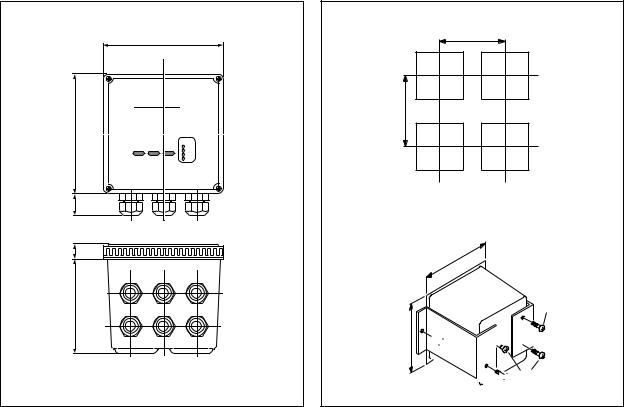
Installation and wiring 3-1
3. INSTALLATION AND WIRING
3-1. Installation and dimensions
3-1-1. Installation site
The EXA converter is weatherproof and can be installed inside or outside. It should, however, be installed as close as possible to the sensor to avoid long cable runs between sensor and converter. In any case, the cable length should not exceed 50 meters (162 feet). Select an installation site where:
●Mechanical vibrations and shocks are negligible
●No relay/power switches are in the direct environment
●Access is possible to the cable glands (see figure 3-1)
●The transmitter is not mounted in direct sunlight or severe weather conditions
●Maintenance procedures are possible (avoiding corrosive environments)
The ambient temperature and humidity of the installation environment must be within the limits of the instrument specifications. (See chapter 2).
3-1-2. Mounting methods
Refer to figures 3-2 and 3-3. Note that the EXA converter has universal mounting capabilities:
●Panel mounting using optional brackets
●Surface mounting on a plate (using bolts from the back)
●Wall mounting on a bracket (for example, on a solid wall)
●Pipe mounting using a bracket on a horizontal or vertical pipe (maximum pipe diameter 50 mm)
144(5.67) 144(5.67) 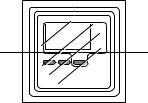
24(1)
16.5
(0.65)
115.5(4.55)
Figure 3-1. Housing dimensions and layout of glands
min.185 (7.25) |
min.195 (7.75) |
cut - out = 138 x 138 (5.43 x 5.43) |
|
|
|
(5 |
.4 |
3 |
) |
|
|
|
|
|||
|
|
8 |
|
|
||
1 |
3 |
|
|
|
||
|
|
|
|
|||
|
|
|
|
|
||
|
|
|
|
|
|
M6
138


 M5
M5 








 M6
M6
Figure 3-2. Panel mounting diagram
IM 12B6B3-E-E
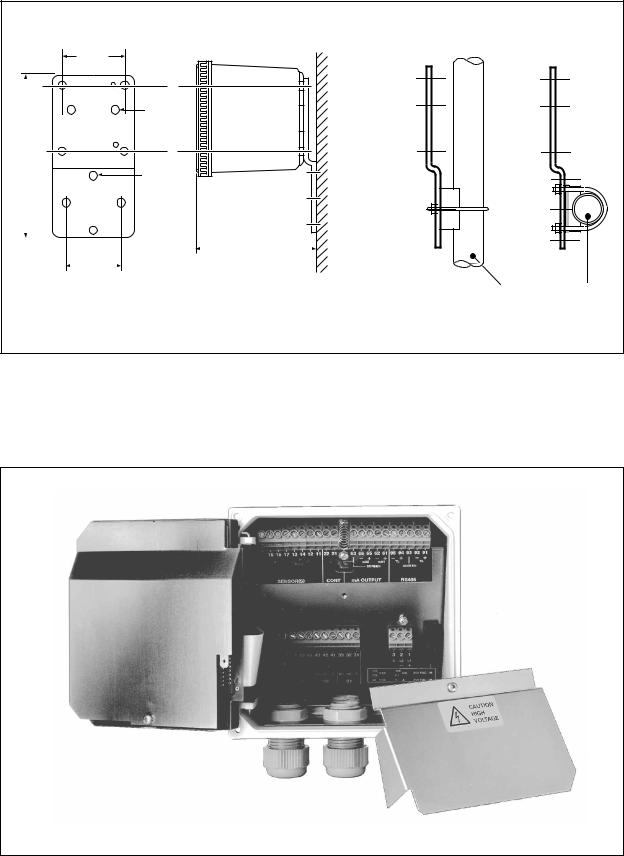
3-2 Installation and wiring
200 |
|
(7.87) |
|
|
|
|
|
|
wall mounting |
pipe mounting |
pipe mounting |
80 |
(vertical) |
(horizontal) |
|
|
|
(3.15) |
|
|
2x ø6.5 |
|
|
(0.26) |
|
|
4x ø10 |
|
|
(0.4) |
|
|
|
|
145 |
|
|
|
|
|
||
70 |
(5.70) |
|
|
|
|
|
|
|
|
|
|
|
|
|
(2.75) |
|
|
|
|
2” ND. pipe
OPTION/U: Universal pipe/wall mounting kit
Figure 3-3. Wall and pipe mounting diagram
Figure 3-4. Internal view of EXA wiring compartment
IM 12B6B3-E-E
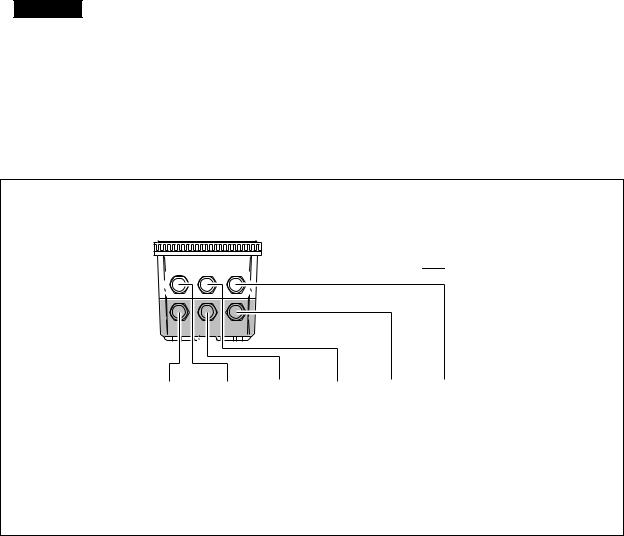
Installation and wiring 3-3
3-2. Preparation
Refer to figure 3-4. The relay contact terminals and power supply connections are under the screening (shielding) plate. These should be connected first. Connect the sensor, outputs and data communication connections last.
To open the EXA 402 for wiring:
1.Loosen the four frontplate screws and remove the cover.
2.Use the rubber knob in the lower righthand corner and swing open the display board to the left.
3.The upper terminal strip is now visible.
4.Remove the screen (shield) plate covering the lower terminal strip.
5.Connect the power supply and contact outputs. Use the three glands at the back for these cables.
6.Replace the screen (shield) plate over the lower terminals.
WARNING Always replace the screen plate over the power and contact outputs for safety and avoid interference.
7.Connect the analog output(s), the sensor input, and, if necessary, the RS485 serial bus.
8.Use the front three glands for analog output, sensor input, contact input and communication cabling (see figure 3-5).
9.Close the display board and switch on the power. Commission the instrument as required or use the default settings.
10.Replace the cover and secure frontplate with the four screws.

 High voltage section
High voltage section
Contact |
Sensor |
Contact |
Analog |
|
Communi- |
|
(S3,S4,FAIL) |
(S1,S2) |
Power |
cation, |
|||
output |
||||||
output |
cables |
output |
cable |
contact |
||
cables |
||||||
cables |
|
cables |
|
input |
||
|
|
|
||||
|
|
|
|
|
|
Suitable for cables with an outside diameter between 7 - 12 mm (9/32 - 15/32 in.)
Figure 3-5. Glands to be used for cabling
IM 12B6B3-E-E
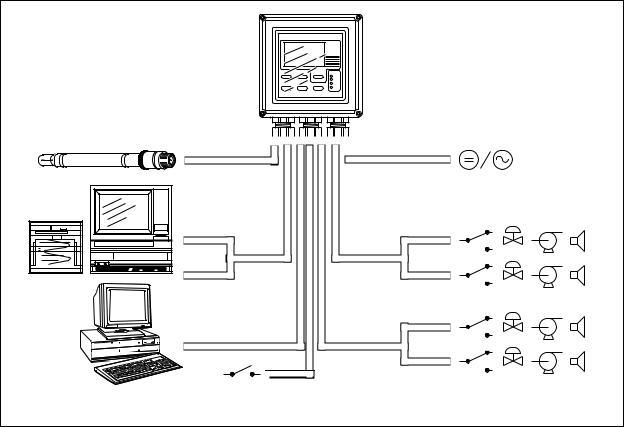
3-4 Installation and wiring
FRONT GLANDS |
REAR GLANDS |
Sensor Power
Power
0/4-20 mA |
Output |
Contact |
S1 |
|
signals |
||
|
output |
|
|
|
|
|
|
|
|
|
S2 |
0/4-20 mA |
|
|
|
|
RS485 |
Contact |
S3/WASH |
|
output |
|
|
|
|
|
S4/FAIL |
Contact input |
|
|
|
Figure 3-6. System configuration
3-3. Wiring the power supply
3-3-1. General precautions
Make sure the power supply is switched off. Also, make sure that the power supply is correct for the specifications of the EXA and that the supply agrees with the voltage specified on the nameplate. Remove the front cover by unscrewing the four screws to check this nameplate on the top of the display board.
Local health and safety regulations may require an external circuit breaker to be installed. The instrument is protected internally by a fuse. The fuse rating is dependent on the supply to the instrument. The 250 VAC fuses should be of the “time-lag” type, conforming to IEC127.
Fuse ratings are 230 VAC - 50 mA; 100 VAC - 100 mA; 115 VAC - 100 mA; 24 VDC - 1.0 A.
The internal fuse is located next to the power terminals (in the lower righthand corner).
3-3-2. Access to terminal and cable entry
Terminals 1, 2 and 3 on the bottom terminal strip are used for the power supply. Guide the power cables through the gland closest to the power supply terminals. The terminals will accept wires of 2.5 mm2 (14 AWG). Use cable finishings if possible.
Connect the wires as indicated in the wiring diagram (refer to figure 3-6).
IM 12B6B3-E-E
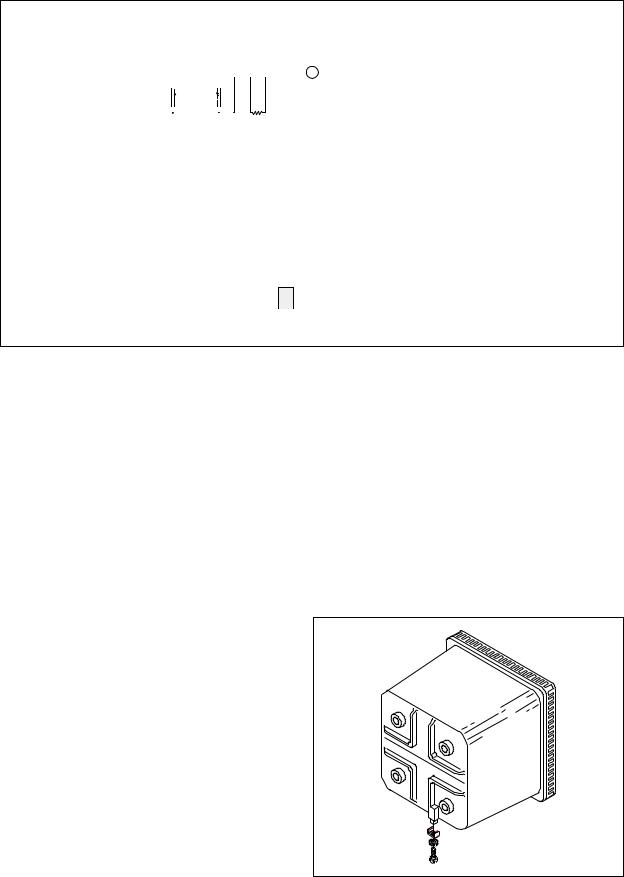
Installation and wiring 3-5
|
|
|
|
|
|
|
|
|
|
|
|
|
|
Contact |
|
|
|
|
|
|
|
|
|
|
|
|
|
|
|
|
|
|
Digital |
|
|
|
|
|
|
|
|
|
|||||||||
Sensor Inputs |
|
|
|
|
|
|
|
|
|
Input |
|
|
mA Outputs |
|
|
|
|
|
|
|
|
|
|
|
|
Communications |
|
|
|
||||||||||||||||||||||
|
|
|
|
|
|
|
|
|
|
|
|
|
|
|
|
|
|
|
|
|
|
|
|
|
|
|
|
|
|
|
|
|
|
|
|
|
|
|
|
|
|
|
|
|
|
|
|
|
|
|
|
|
|
|
|
|
|
|
|
|
|
|
|
|
|
|
|
|
|
|
|
|
|
|
|
|
|
|
|
|
|
|
|
|
|
|
|
|
|
|
|
|
|
|
|
|
|
|
|
|
|
|
|
|
15 |
16 |
17 |
13 |
14 |
12 |
11 |
22 |
21 |
63 |
66 |
65 |
62 |
61 |
95 |
94 |
93 |
92 |
91 |
||||||||||||||||||||||||||||||||
|
|
|
|
|
|
|
|
|
|
|
|
|
|
|
|
|
|
|
|
|
|
|
|
|
|
|
|
|
|
|
|
|
|
|
|
|
|
|
|
|
|
|
|
|
|
|
|
|
|
||
|
|
|
|
|
|
|
|
|
|
|
|
|
|
|
|
|
|
|
|
|
|
mA2 |
|
|
|
|
|
mA1 |
|
|
|
|
|
TL |
|
|
|
|
|
|
TL |
||||||||||
|
|
|
|
|
|
|
|
|
|
|
|
|
|
|
|
|
|
|
|
|
|
|
|
|
|
SCREEN |
|
|
|
|
|
|
|
SCREEN |
|
|
|
|
|||||||||||||
|
|
|
|
|
|
|
|
|
|
|
|
|
|
|
|
|
|
|
|
|
|
|
|
|
|
|
|
|
|
|
|
|
|
|
|
|
|
|
|
|
|
|
|
||||||||
|
|
|
|
|
|
|
|
|
|
|
|
|
|
|
|
|
|
|
|
|
|
|
|
|
|
|
|
|
|
|
|
|
|
|
|
|
|
|
|
|
|
|
|
||||||||
|
|
|
|
|
|
|
|
|
|
|
|
|
|
|
|
|
|
|
|
|
|
|
|
|
|
|
|
|
|
|
|
|
|
|
|
|
|
|
|
|
|
|
|
|
|
|
|
||||
|
pH/ORP |
|
|
ref. liquid |
|
temp. |
|
|
|
|
|
|
|
|
|
|
|
|
|
|
|
|
|
|
|
|
|
|
|
|
|
|
|
|
|
|
|
|
|
|
|
|
|
|
|||||||
|
|
|
|
|
|
|
|
earth |
|
sens. |
|
|
|
|
|
|
|
|
|
|
|
|
|
|
|
|
|
|
|
|
|
|
|
|
|
|
|
|
|
|
|
|
|
|
|
|
|
|
|||
|
|
|
|
SENSOR(S) |
|
|
|
|
CONT |
|
|
mA OUTPUT |
|
|
|
|
|
|
|
|
|
RS485 |
|
|
|
||||||||||||||||||||||||||
|
Relay Contacts |
|
|
|
|
|
|
|
|
|
|
|
|
|
|
|
|
Power Supply |
|
|
|
|
|
|
|
||||||||||
|
|
|
|
|
|
|
|
|
|
|
|
|
|
|
|
|
|
|
|
|
|
|
|
|
|
|
|
|
|
|
|
|
|
|
|
|
|
|
|
|
|
|
|
|
|
|
|
|
|
|
|
|
|
|
|
|
|
|
|
|
|
|
|
|
|
|
|
|
|
|
|
|
71 |
72 |
73 |
51 |
52 |
53 |
41 |
42 |
43 |
31 |
32 |
33 |
|
|
3 |
2 |
1 |
|
|
|
|||||||||||||||
|
250V AC |
250VDC |
|
|
|
|
|
|
|
|
|
|
|
|
|
|
|
|
|
|
|
|
|
|
|
|
|
|
FUSE |
|
|||||
|
|
5A |
|
|
5A |
|
|
|
|
|
|
|
|
|
|
|
|
|
|
|
|
|
|
|
|
|
|
|
|
|
|
|
|
|
|
|
100V A |
50W |
|
|
|
|
|
|
|
|
|
|
|
|
|
|
|
|
|
|
|
|
|
|
|
|
|
|
|
|
|
||||
|
|
|
|
|
|
|
|
|
|
|
|
|
|
|
|
|
|
|
|
|
|
|
|
|
|
100 |
VAC |
100 |
mA |
|
|
|
|||
|
C |
NC |
NO |
C |
NC |
NO |
C |
NC |
NO |
C |
NC |
NO |
|
115 |
VAC |
100 |
mA |
250VAC; T |
|
||||||||||||||||
|
|
230 |
VAC |
50 |
mA |
|
|||||||||||||||||||||||||||||
|
|
|
S4 |
|
|
|
|
S3 |
|
|
|
|
S2 |
|
|
|
|
S1 |
|
|
|
24 |
VDC |
1 |
|
A |
|
|
|
||||||
|
|
|
|
|
|
|
|
|
|
|
|
|
|
|
|
|
|
|
|
|
|
|
|
|
|
|
|
|
|
|
|
|
|
|
|
High voltage compartment
Figure 3-7. Input and output connections
3-3-3. AC power
Connect terminal 1 to the phase line of the AC power and terminal 2 to the zero line. Terminal 3 is for the power ground. This is separated from input ground by a galvanic isolation.
3-3-4. DC power
Connect terminal 1 to the positive outlet and terminal 2 to the negative outlet. Terminal 3 is for the power ground. This is separated from input ground by a galvanic isolation. A 2-core screened cable should be used with the screen connected to terminal 3. The size of conductors should be at least 1.25 mm2. The overall cable diameter should be between 7 & 12 mm.
3-3-5. Grounding the housing
To protect the instrument against interference, the housing should be connected to ground by a large area conductor. This cable can be fixed to the rear of the housing using a braided wire cable. See figure 3-8.
3-3-6. Switching on the instrument
After all connections are made and checked, the power can be switched on from the power supply. Make sure the LCD display comes on. All segments will illuminate, then the instrument will momentarily display its unique serial number. After a brief interval, the display will change to the measured value. If errors are displayed or a valid measured value is not shown, consult the troubleshooting section (Chapter 8) before calling Yokogawa.
Figure 3-8. Grounding the housing
IM 12B6B3-E-E
3-6 Installation and wiring
3-4. Wiring the contact signals
3-4-1. General precautions
The contact output signals consist of voltage-free relay contacts for switching electrical appliances (SPDT). They can also be used as digital outputs to signal processing equipment (such as a controller or PLC). It is possible to use multi-core cables for the contact in and output signals and shielded multi-core cable for the analog signals.
3-4-2. Contact outputs
The EXA unit’s four contact outputs can be wired to suit your own custom requirements (Figure 3-6).
In the Non-Alarm or Power Off states, contacts S1, S2 and S3 are OFF, Common (C) and Normally Closed (NC) are in contact.
In the “Fail” or Power Off states, contact S4 is ON, Common (C) and Normally Closed (NC) are in contact.
You can either use them to switch AC power, or switch a DC Voltage for digital interfacing. Default settings
●The contact S1 is pre-programmed for high alarm function.
●The contact S2 is pre-programmed for a low alarm function.
●The contact S3 is not activated as an alarm (off).
●The contact S4 is pre-programmed for FAIL.
The three control contacts (S1 to S3) can be used for simple process control by programming their function (Chapter 5). The FAIL contact is programmed to signal a fault in the measuring loop. Always connect the FAIL contact to an alarm device such as a warning light, sound annunciator, or alarm panel to make full use of the fault detection possibilities (self diagnostics) of the EXA converter.
3-5. Wiring the analog output signals
3-5-1. General precautions
The analog output signals of the EXA transmit low power standard industry signals to peripherals like control systems or strip-chart recorders (Figure 3-6).
3-5-2. Analog output signals
The output signals consist of active current signals of either 0-20 mA or 4-20 mA. The maximum load can be 600 ohms on each.
It is necessary to use screening/shielding on the output signal cables. Terminal 63 is used to connect the shielding.
IM 12B6B3-E-E
Installation and wiring 3-7
3-6. Wiring the sensor system
3-6-1. Impedance measurement jumper settings
NOTE:
It is important to decide first which application and which settings are appropriate for the installation. This decision is best done before the jumpers are installed, because the cables will rest on top of the jumpers in their installed positions.
Table 3-1. Impedance measuring jumpers
Figure no. |
Jumper Settings |
Jumper Settings |
Application & Sensor Connections |
|
Input #1 |
Input #2 |
|
|
|
|
|
1 |
High Impedance |
Low Impedance |
Normal pH sensors |
|
|
|
Glass sensor on Input #1 |
|
|
|
Reference sensor on Input #2 |
|
|
|
|
2 |
High Impedance |
High Impedance |
Special electrodes using |
|
|
|
2 glass sensors |
|
|
|
(e.g. Pfaudler 18) |
|
|
|
|
3 |
Low Impedance |
High Impedance |
ORP (pH compensated) and/or rH |
|
|
|
metal sensor on Input #1 |
|
|
|
pH glass (as reference) on Input #2 |
|
|
|
|
4 |
Low Impedance |
Low Impedance |
ORP (Redox measurement) |
|
|
|
metal sensor on Input #1 |
|
|
|
Normal reference on Input #2 |
|
|
|
|
The following four jumper figure illustrations (figure 3-9) show the jumper positions related to the figure numbers in the above table.
IM 12B6B3-E-E
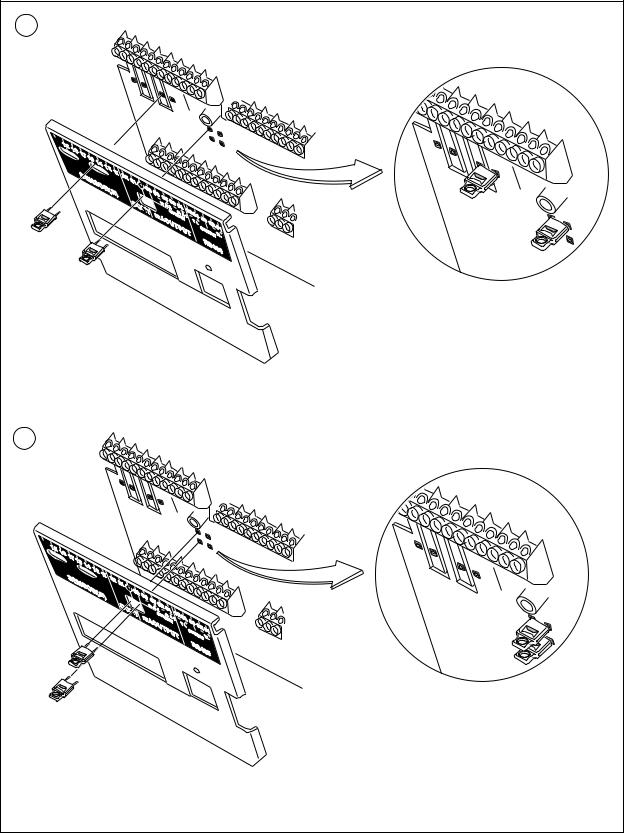
3-8 Installation wiring
1
Default jumper connections for : - Input 1, High impedance
- Input 2, Low impedance Service code 03 = 1.1.1
- Input 1, High impedance, Temp. comp., Check on Service code 04 = 0.0.1
- Input 2, Low impedance, Temp. comp. off, Check on
2
Jumper connections for : - Input 1, High impedance - Input 2, High impedance Service code 03 = 1.0.1
- Input 1, High impedance, Temp. comp. off, Check on Service code 04 = 1.0.1
- Input 2, Low impedance, Temp. comp. off, Check on
Figure 3-9a. Impedance measurement jumper setting
IM 12B6B3-E-E
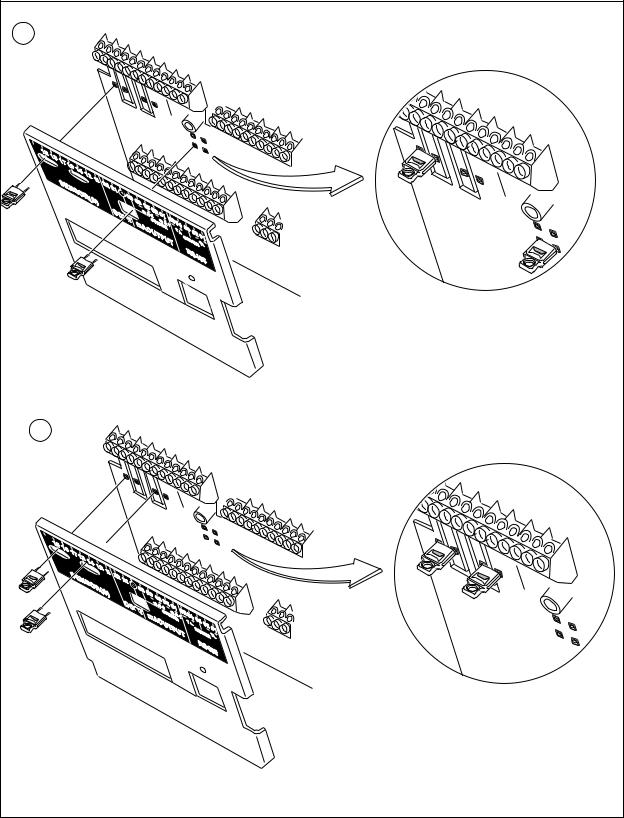
Installation and wiring 3-9
3
Jumper connections for : - Input 1, Low impedance - Input 2, High impedance Service code 03 = 0.0.1
- Input 1, Low impedance, Temp. comp. off, Check on Service code 04 = 1.1.1
- Input 2, High impedance, Temp. comp. on, Check on
4
Jumper connections for : - Input 1, Low impedance - Input 2, Low impedance Service code 03 = 0.0.1
- Input 1, Low impedance, Temp. comp. off, Check on Service code 04 = 0.0.1
- Input 2, Low impedance, Temp. comp. off, Check on
Figure 3-9b. Impedance measurement jumper setting
IM 12B6B3-E-E
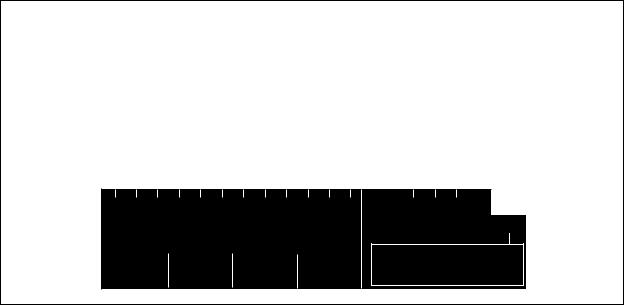
3-10 Installation and wiring
|
Sensor inputs |
|
|
|
|
Contact |
mA |
|
|
|
|
Digital |
|
|
|
||
|
|
|
|
|
input |
outputs |
|
|
|
communications |
|||||||
|
|
|
|
|
|
|
|
|
|
|
|
|
|
|
|
|
|
|
15 16 |
17 |
13 |
14 |
12 |
11 |
22 21 |
63 |
66 |
65 |
62 |
61 |
95 |
94 |
93 |
92 |
91 |
|
|
|
|
|
|
|
|
|
mA2 |
|
mA1 |
|
TL |
|
|
|
TL |
|
|
|
|
|
|
|
|
|
|
SCREEN |
|
|
|
SCREEN |
|
|
|
|
INPUT 1 |
|
INPUT 2 |
|
|
INPUT 1 |
|
|
|
|
|
|
|
|
|
|
|
|
|
|
|
HIGH IMP |
|
|
|
|
|
|
|
|
|
|
|||
|
LOW IMP |
|
LOW IMP |
|
|
INPUT 2 |
|
|
|
|
|
|
|
|
|
|
|
|
|
|
|
|
|
|
|
|
|
|
|
|
|
|
|
|
|
|
|
|
|
|
|
|
HIGH IMP |
|
|
|
|
|
|
|
|
|
|
|
Sensor(s) |
|
|
|
Cont |
|
mA output |
|
|
RS485 |
|
||||||
|
|
|
|
|
|
|
|
|
|
|
|
|
|
|
|||
|
|
|
|
|
|
|
|
|
|
|
|
|
|
|
|||
Relay contacts |
|
|
|
|
|
|
|
|
Power supply |
|
|
|
|
||||
71 |
72 |
73 |
51 |
52 |
53 |
41 |
42 |
43 |
31 |
32 |
33 |
250V AC |
250VDC |
|
|
|
|
|
|
|
|
|
|
5A |
|
5A |
|
|
|
|
|
|
|
|
|
100V |
A |
50W |
|
|
|
|
|
|
|
|
|
C |
NC |
NO |
C NC |
NO C NC NO C NC NO |
|||||||
|
S4 |
|
|
S3 |
|
|
S2 |
|
|
S1 |
|
|
3 |
2 |
1 |
|
|
100 |
VAC |
100 |
mA |
|
Fuse |
|
|
||||
|
|
|
|
||
115 |
VAC |
100 |
mA |
|
|
230 |
VAC |
50 |
mA |
250VAC; T |
|
|
|
|
|
||
24 |
VDC |
1 |
A |
|
|
|
|
|
|
||
Figure 3-10. Terminal identification labels
3-7. Sensor wiring
Refer to figure 3-11, which includes drawings that outline sensor wiring.
The EXA PH402 can be used with a wide range of commercially available sensor types, both from Yokogawa and other manufacturers. The sensor systems from Yokogawa fall into two categories; the ones that use a fixed cable and the ones with separate cables.
To connect sensors with fixed cables, simply match the terminal numbers in the instrument with the identification numbers in the instrument on the cable ends.
The separate sensors and cables are not numbered, but instead use a color-coding system. The electrodes have a colored band incorporated in the label on the connection cap:
● Red for measuring electrodes (both pH and ORP)
●Yellow for reference electrodes
●Blue for combined sensors with both measuring and reference elements in the same body
●Green for temperature sensors
The recommended procedure is to color-code each end of the cables to match the sensors with the color strips provided with each cable. This provides a quick way to identify the ends of the cables belonging to a particular sensor when they are installed. (The procedure for fixing the identification labels is described in detail in the instruction sheet provided with the cable.)
IM 12B6B3-E-E
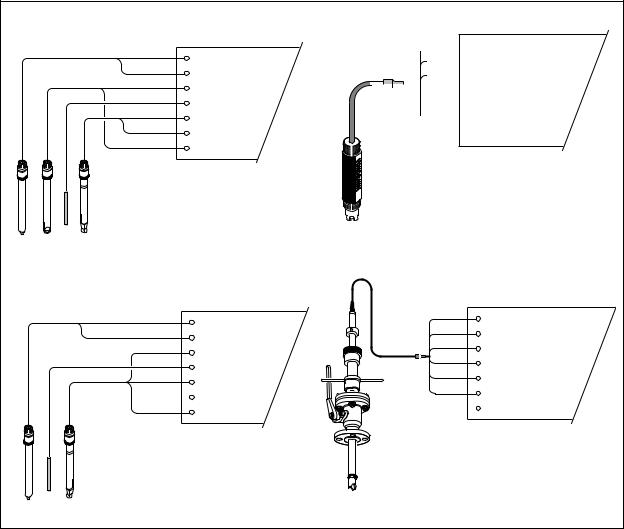
Installation and wiring 3-11
3-7-1. Connection cable
There are two types of connection cable, one for single sensors and one for combined sensors. The former is a coaxial cable and has only two connections.
● |
Red |
to measuring element |
● |
Blue |
to screen (shield) |
The latter is a triaxial cable with three connections, (it has an extra white wire termination) these wires are connected:
● Red
● Blue
● White
To connect the other sensor systems, follow the general pattern of the terminal connections as listed below:
11 & 12 |
Temperature compensation resistor input (Pt100, Pt1000, 3k, 5k1, 8k55 and 10k PTC ) |
13 |
Input no. 2 (normally the reference element) |
17 |
Screen (shield) for input no. 2 |
14Liquid earth (solution ground) connection
15Input no. 1 (normally the measuring element)
16Screen (shield) for input no. 1
Green * |
|
pH transmitter |
||
Red |
11 |
Temperature |
||
|
Blue |
|||
|
12 |
Temperature |
||
Yellow * |
Red |
|||
13 Reference |
||||
|
Black |
14 |
Solution ground |
|
Red * |
Red |
|||
15 Glass (measure) |
||||
|
Blue |
16 |
Shield |
|
|
Blue |
|||
|
17 |
Shield |
||
|
|
|||
|
* Cable markers |
|||

 11 Temperature
11 Temperature
 12 Temperature
12 Temperature
 13 Reference
13 Reference




 14 Solution ground
14 Solution ground

 15 Glass (measure)
15 Glass (measure)

 16 Shield
16 Shield  17
17
FU20/FU25 4-in one sensor
Note: Connect cables to similarly marked terminals: 11 to 11, 12 to 12, etc.
Green |
* |
Red |
11 Temperature |
11 Temperature |
||
|
Blue |
|||||
|
|
12 |
Temperature |
12 |
Temperature |
|
|
|
Blue |
13 |
Reference |
||
|
|
13 |
Reference |
|||
|
|
Black |
14 |
Solution ground |
||
|
Blue * |
14 |
Solution ground |
|||
|
Red |
15 Glass (measure) |
||||
|
15 Glass (measure) |
|||||
|
|
|
16 |
Shield |
16 |
Shield |
|
|
White |
17 |
Shield |
||
|
|
17 |
Shield |
|||
|
|
|
|
|
||
* Cable markers
Combined pH/ref sensors
Retractable sensor assembly PR20
(Also PD20, PF20 & PS20)
NOTE:
Connect cables to similarly marked terminals: 11 to 11, 12 to 12, etc.
Figure 3-11a. Sensor wiring
IM 12B6B3-E-E
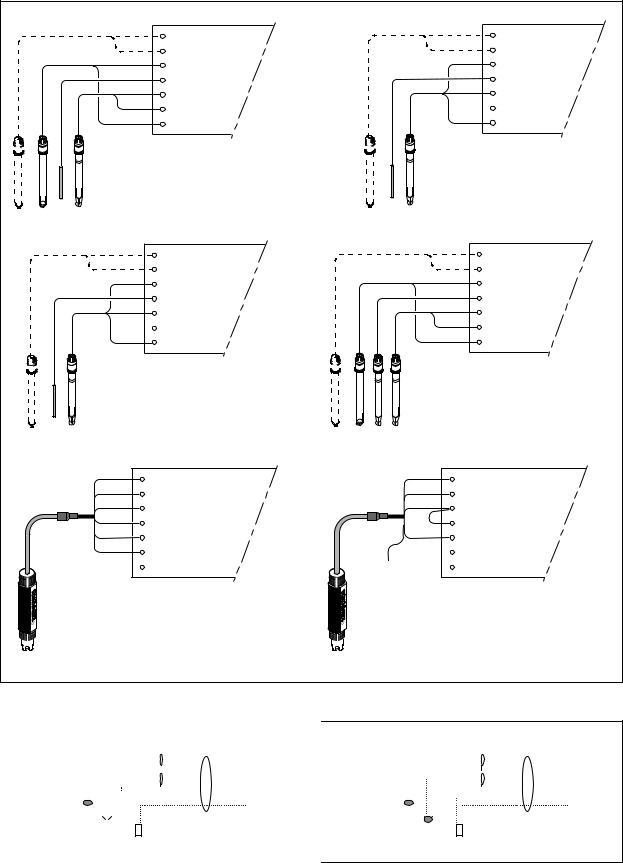
3-12 Installation and wiring
Green* |
RED |
TEMPERATURE |
|
11 |
|
|
BLUE |
TEMPERATURE |
Yellow* |
12 |
|
RED |
REFERENCE |
|
|
13 |
|
|
BLACK |
SOLUTION GROUND |
Red* |
14 |
|
RED |
GLASS (MEASURE) |
|
|
15 |
|
|
BLUE |
SHIELD |
|
16 |
|
|
BLUE |
SHIELD |
|
17 |
|
|
* Cable Markers |
|
Separate sensors ORP
Temp. sensors optional for indication only, not for compensation
Service code 01 set to ORP
Green* |
RED |
11 |
TEMPERATURE |
|
|
||
|
BLUE |
12 |
TEMPERATURE |
|
|
||
|
BLUE |
13 |
REFERENCE |
|
|
||
Blue* |
BLACK |
14 |
SOLUTION GROUND |
|
|||
RED |
15 |
GLASS (MEASURE) |
|
|
|
||
|
|
16 |
SHIELD |
|
WHITE |
17 |
SHIELD |
|
|
||
|
* Cable Markers |
||
Combined pH/ORP sensor
Temp. sensors optional for indication only, not for compensation
Service code 01 set to ORP
11 |
TEMPERATURE |
12 |
TEMPERATURE |
13 |
REFERENCE |
14 |
SOLUTION GROUND (ORP) |
15 |
pH |
16 |
SHIELD |
17 |
|
"All in one" pH & ORP (or rH)
Service code 01 set to pH Service code 02 set to ORP (or rH)
Green* |
RED |
11 |
TEMPERATURE |
|
|
||
|
BLUE |
12 |
TEMPERATURE |
|
|
||
|
BLUE |
13 |
REFERENCE |
|
|
||
Blue* |
BLACK |
14 |
SOLUTION GROUND |
|
|||
RED |
15 |
GLASS (MEASURE) |
|
|
|
||
|
|
16 |
SHIELD |
|
WHITE |
17 |
SHIELD |
|
|
||
|
|
* Cable Markers |
|
Separate sensors ORP/ref sensor
Temp. sensors optional for indication only, not for compensation
Service code 01 set to ORP
Green* |
RED |
TEMPERATURE |
|
11 |
|
|
BLUE |
TEMPERATURE |
Yellow* |
12 |
|
RED |
REFERENCE |
|
|
13 |
|
|
BLACK |
METAL ORP SENSOR |
Red* |
14 |
|
RED |
GLASS (MEASURE) |
|
|
15 |
|
|
BLUE |
SHIELD |
|
16 |
|
|
BLUE |
SHIELD |
|
17 |
|
|
* Cable Markers |
|
Separate sensors pH & ORP (or rH)
Temp. sensors optional for indication only, not for compensation
Service code 01 set to pH Service code 02 set to ORP (or rH)
|
11 |
11 |
TEMPERATURE |
|
|
||
|
12 |
12 |
TEMPERATURE |
|
|
||
|
13 |
13 |
REFERENCE |
|
|
||
|
|
14 |
SOLUTION GROUND (ORP) |
|
14 |
15 |
pH |
|
|
||
16 |
15 |
16 |
SHIELD |
17 |
|
||
|
|
|
"All in one" ORP
Service code 01 set to ORP Service code 03 set to off Service code 04 set to off
Figure 3-11b. Sensor wiring
> Connect ions normal pH |
|
|
> Connections differential pH |
||||||||||||||||||
|
|
|
|
|
|
|
|
|
|
A- |
|
|
|
|
|
|
|
|
|
|
|
|
|
|
|
|
|
|
|
|
|
B-13 |
|
|
|
|
|
|
|
|
|
|
|
|
|
|
|
|
|
|
|
|
|
|
|
|
|
|
|
|
|
|
|
|
|
|
|
|
|
|
|
|
|
|
|
C- |
|
|
|
|
|
|
|
|
|
|
|
|
|
|
|
|
|
|
|
|
|
D-14 |
|
|
|
|
|
|
|
|
|
|
|
|
|
|
|
|
|
|
|
|
|
E-11 |
|
|
|
|
|
|
|
|
|
|
|
pH |
|
|
|
|
|
|
|
F-12 |
|
pH |
|
|
|
|
|
|
|
||||
|
|
|
|
|
|
|
S-3 or 63 |
|
|
|
|
|
|
|
|
||||||
|
|
|
|
||||||||||||||||||
|
|
ref |
|
|
|
|
|
|
|
|
|
|
|
|
|
|
|
||||
|
|
|
|
|
|
LE |
|
|
|
|
|
pH ref LE |
|
|
|||||||
|
|
|
|
|
|
|
temp |
|
|
|
|
|
|
|
|
|
temp |
||||
|
|
|
|
|
|
|
|
|
|
|
|
|
|
|
|
|
|
|
|
|
|
A- B-14 C-13 D-17 E-11 F-12
S-3 or 63
IM 12B6B3-E-E
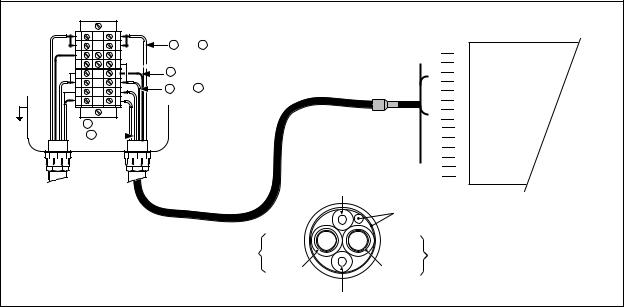
Installation and wiring 3-13
3-7-2. Sensor cable connection with special grommet
In order to seal multiple sensor cables into EXA PH402, a special grommet is provided that is designed to accommodate one, two or three sensor cables (5 mm dia.) plus a liquid earth cable (2.5 mm dia.). In the pack with the grommet are blanking pieces to close any unused holes. When correctly assembled, the grommet maintains the IP65 (NEMA 4X) rating of the EXA PH402 housing.
Refer to figure 3-12 to assemble the grommet connections:
1.First remove the nut and standard rubber seal from the selected gland
2.Discard the seal. This will be replaced later by the special grommet
3.Thread the cables through the nut and the gland
4.Connect the cables to their designated terminals
5.Arrange the cables to avoid tangles and insert the grommet between the gland and the nut
6.The grommet is split to permit the cables to be mounted after connection. (This also ensures even length adjustment.)
7.Ensure that any unused holes are filled with the blanking pieces
8.Tighten the nut to form a firm seal. (Hand-tight is sufficient.)
Note: The special gland is intended to be used to seal the multiple cables from the Yokogawa flow fittings such as FF20 and FP20. The designated cables are WU20 sensor cables, which are approximately 5 mm (0.2 “) in diameter, and 82895002 liquid earth cables, which are approximately 2.5 mm (0.1 “) in diameter.
For sensor systems using a single cable, like the FU20 (FU25) and the PR20, PD20, PF20 and PS20, the standard gland will accommodate the cable adequately. Single cables between approximately 7 mm and 12 mm (0.28 “ and 0.47 “) can be sealed properly with these glands.
3-7-3. Sensor cable connections using junction box (BA10) and extension cable (WF10)
Where a convenient installation is not possible using the standard cables between sensors and converter, a junction box and extension cable may be used. The Yokogawa BA10 junction box and the WF10 extension cable should be used. These items are manufactured to a very high standard and are necessary to ensure that the specifications of the system can be met. The total cable length should not exceed 50 metres
(e.g. 5 m fixed cable and 45 m extension cable). In the case of systems using dual high impedance sensors (e.g. Pfaudler 18), then the cable length is restricted to 20 metres (fixed cable only, no extension with F10).
15 |
15 |
16 |
16 |
14 |
14 |
14 |
14 |
17 |
17 |
13 |
13 |
12 |
12 |
11 |
11 |
11 Red 
12 Blue 
15 Core 16 Screen White Co-axial cable
17 Overall Screen
13 Core 14 Screen
Brown Co-axial Cable
EXA pH TRANSMITTER / CONVERTER

 11
11  11
11
 12
12  12
12
WF10 Cable

 13
13 
 13
13
 17
17  14
14

 15
15 
 15
15

 16
16  16
16

 14
14 
 17
17
12 (blue)
15 (core) 

Co-axial cable 
(white)
16 (screen)
Note that cables 14 & 17 connect to
terminals 17 & 14 respectively.
17 (overall screen)

 13 (core)
13 (core)
|
Co-axial cable |
14 (screen) |
(brown) |
|
11 (red)
Fig. 3-12. Connection of WF10 extension cable and BA10/BP10 junction box
IM 12B6B3-E-E
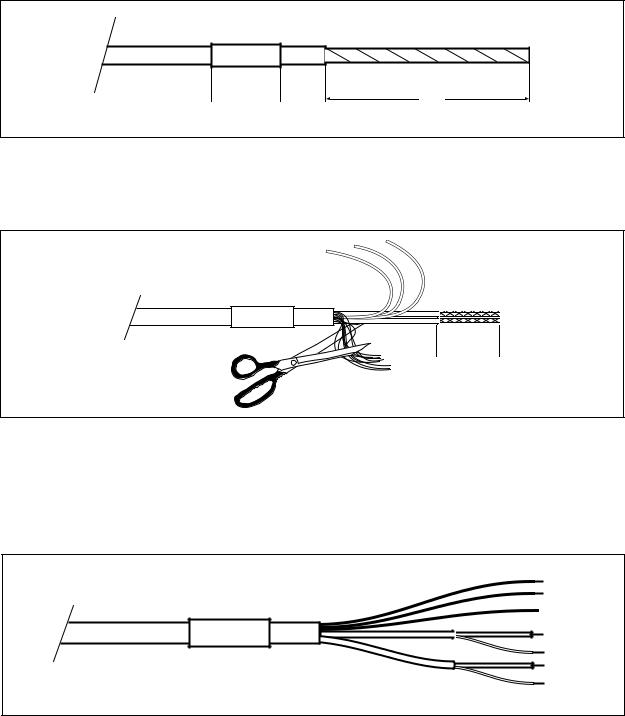
3-14 Installation and wiring
Extension cable may be purchased in bulk quantities or in pre-finished lengths. In the case of bulk quantities cut to length, then it is necessary to terminate the cable as shown below.
Termination procedure for WF10 cable.
1.Slide 3 cm of heat shrink tube (9 x 1.5) over the cable end to be terminated.
2.Strip 9 cm of the outer (black) insulating material, taking care not to cut or damage internal cores.

 3 cm
3 cm 
 heat shrink
heat shrink
9 cm |
remove insulation
Fig. 3-13a.
3.Remove loose copper screening, and cut off the cotton packing threads as short as possible.
4.Strip insulation from the last 3 cm of the brown, and the white coaxial cores.

 3 cm
3 cm 

cotton threads
Fig. 3-13b.
5.Extract the coaxial cores from the braid, and trim off the black (low-noise) screening material as short as possible.
6.Insulate the overall screen and the 2 coaxial screens with suitable plastic tubing.
7.Strip and terminate all ends with suitable (crimp) terminals and identify with numbers as shown.
11 |
12 |
17 |
15 |
16 |
13 |
14 |
Fig. 3-13.c |
8. Finally shrink the overall heat shrink tube into position.
IM 12B6B3-E-E

Installation and wiring 3-15
Figure 3-14. Sensor cable connections with special grommet
3-8. Tag plate mounting
When option /SCT is specified, a stainless steel tagplate is supplied with the designated Tag No. stamped or engraved. It is mounted as shown in figure 3-14 using one of the cable glands.
IM 12B6B3-E-E
IM 12B6B3-E-E
Operation 4-1
4. OPERATION; DISPLAY FUNCTIONS AND SETTING
4-1. Operator interface
This section provides an overview of the operation of the EXA operator interface. The basic procedures for obtaining access to the three levels of operation are described briefly. For a step-by-step guide to data entry, refer to the relevant section of this instruction manual. Figure 4-1 shows the EXA operator interface.
LEVEL 1: Maintenance
These functions are accessible by pushbutton through a flexible front cover window. The functions make up the normal day-to-day operations that an operator may be required to complete. Adjustment of the display and routine calibration are among the features accessible in this way. (See table 4-1).
LEVEL 2: Commissioning
A second menu is exposed when the EXA front cover is removed and the display board is revealed. Users gain access to this menu by pressing the button marked * in the lower right of the display board. This menu is used to set such values as the output ranges and hold and wash features. It also gives access to the service menu. (See table 4-1).
LEVEL 3: Service
For more advanced configuration selections, press the button marked * , then press “NO” repeatedly until you reach SERVICE. Now push the “YES” button. Selecting and entering “Service Code” numbers in the commissioning menu provide access to the more advanced functions. An explanation of the Service Codes is listed in chapter 5 and an overview table is shown in chapter 10.
Table 4-1. Operations overview
|
Routine |
Function |
Chapter |
Maintenance |
AUT CAL |
Calibration with programmed buffer solutions |
6 |
|
MAN CAL |
Calibration with other buffer solutions |
6 |
|
SAMPLE |
Grab sample calibration |
6 |
|
DISPLAY |
Read auxiliary data or set message display |
4 |
|
SETPOINTS |
Adjust alarm setpoints (when activated) |
5 |
|
WASH |
Manual wash start (when activated) |
5 |
|
MAN.IMP |
Manual start of impedance check |
5 |
|
TEMPERATURE |
Select automatic or manual compensation |
5 |
|
|
|
|
|
HOLD |
Switch hold on/off (when activated) |
5 |
Commissioning |
SETPOINTS |
Adjust alarm setpoints |
5 |
|
RANGE |
Adjust the output range |
5 |
|
SET HOLD |
Activate the hold function |
5 |
|
|
|
|
|
WASH |
Activate and configure the wash timer |
5 |
Service |
SERVICE |
Fine tune the specialized functions of the |
5 |
(Access to coded entries |
|
converter |
|
from the commissioning |
|
|
|
level) |
|
|
|
|
|
|
|
NOTE:
All three levels may be separately protected by a password. See Service Code 52 in chapter 5 Service Code table for details on setting passwords.
IM 12B6B3-E-E
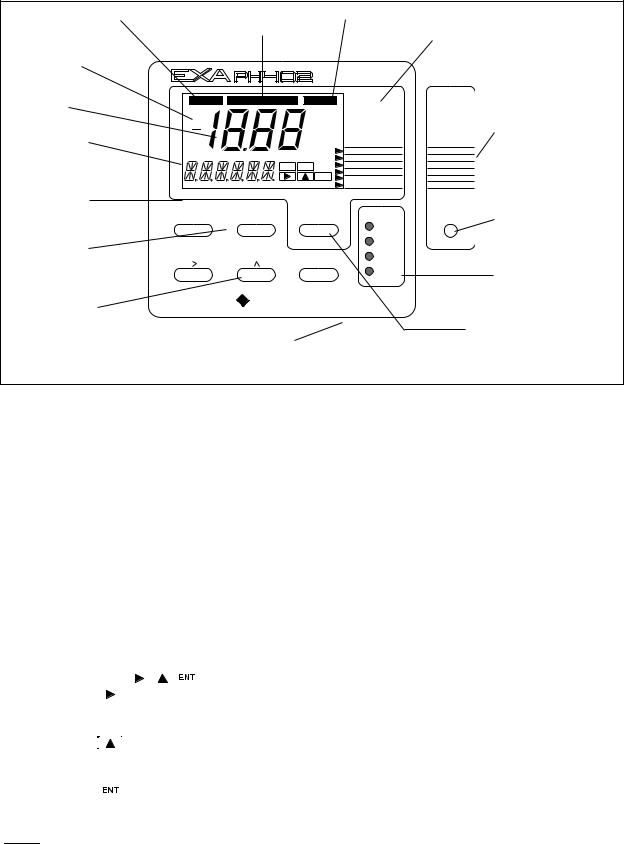
4-2 Operation
Output hold flag |
Manual temperature |
Fail flag |
compensation flag |
|
|
|
Menu pointer flags |
|
|
|
Units
Main display
Message display
Key prompt flags
Selection keys
YES |
: Accept setting |
NO |
: Change setting |
HOLD |
TEMP.MAN. |
FAIL |
MODE |
|
|
pH |
|
|
|
|
Commissioning |
mV |
|
|
|
|
function menu |
|
|
|
|
|
|
|
|
|
MEASURE |
|
|
|
|
|
AUT.CAL |
SETPOINTS |
|
|
YES |
NO |
MAN.CAL |
RANGE |
|
|
DISPLAY |
SET HOLD |
|
||
|
|
ENT |
|
||
|
|
TEMPERATURE |
WASH |
|
|
|
|
|
|
||
|
|
|
HOLD |
SERVICE |
|
Y |
NO |
MODE |
CONTACTS |
* |
Commissioning |
|
mode access key |
||||
|
|
|
S1 |
||
|
|
|
S2 |
|
|
|
|
ENT |
WASH/S3 |
|
Relay contact |
|
|
FAIL/S4 |
|
||
|
|
|
|
status indicators |
|
|
|
|
|
|
Adjustment keys |
YOKOGAWA |
|
>: Choose digit to adjust
^ : Adjust digit ENT : Confirm change
Measure/Maintenance
mode key
Broken line indicates area that can be seen through front cover
Figure 4-1. PH402 operator interface
4-2. Explanation of operating keys
MODE key |
This key toggles between the measuring and maintenance modes. Press once to obtain |
||||||||||
|
|
|
access to the maintenance function menu. |
||||||||
|
|
|
|
|
|
AUTO CAL |
|||||
|
|
|
|
|
|
MAN CAL |
|||||
|
|
|
|
|
|
DISPLAY |
|||||
|
|
|
|
|
|
SETPOINT |
|||||
|
|
|
|
|
|
WASH |
|||||
|
|
|
|
|
|
MAN.IMP |
|||||
|
|
|
|
|
|
TEMPERATURE |
|||||
|
|
|
|
|
|
HOLD |
|||||
|
|
|
Press again to return to the measuring mode (press twice when hold is activated). |
||||||||
YES/NO keys These are used to select choices from the menu. |
|||||||||||
|
|
|
YES |
is used to accept a menu selection. |
|||||||
|
|
|
NO |
is used to reject a selection, or to move ahead to the next option. |
|||||||
DATA ENTRY keys ( |
|
|
|
|
|
) |
|||||
|
|
|
|
|
|||||||
|
|
|
|
|
|
is used as a “cursor” key. Each press on this key moves the cursor or flashing digit |
|||||
|
|
|
|
|
|
||||||
|
|
|
|
|
|
one place to the right. This is used to select the digit to be changed when entering |
|||||
|
|
|
|
|
|
numerical data. |
|||||
|
|
|
|
|
|
is used to change the value of a selected digit. Each press on this key increases the |
|||||
|
|
|
|
|
|
||||||
|
|
|
|
|
|
||||||
|
|
|
|
|
|
value by one unit.The value can not be decreased, so in order to obtain a lower value, |
|||||
|
|
|
|
|
|
increase past nine to zero, then increase to the required number. |
|||||
|
|
|
|
|
|
When the required value has been set using the > & ^ keys, press ENT to confirm the |
|||||
|
|
|
|
|
|
||||||
|
|
|
|
|
|
data entry. Please note that the EXA 402 does not register any change of data until |
|||||
|
|
|
|
|
|
the ENT key is pressed. |
|||||
|
|
key |
This is the commissioning mode key. It is used to obtain access to the commissioning |
||||||||
|
* |
||||||||||
menu. This can only be done with the cover removed or opened. Once this button has been used to initiate the commissioning menu, follow the prompts and use the other keys as described above.
IM 12B6B3-E-E
Operation 4-3
4-3. Setting passcodes
4-3-1. Passcode protection
In Service Code 52, EXA users can set passcode protection for each one of the three operating levels, or for any one or two of the three levels. This procedure should be completed after the initial commissioning (setup) of the instrument. The passcodes should then be recorded safely for future reference.
When passcodes have been set, the following additional steps are introduced to the configuration and programming operations:
Maintenance
Press MODE key. The display shows 000 and *PASS*
Enter a 3-digit passcode as set in Service Code 52 to obtain access to the Maintenance Mode
Commissioning
Press * key. The display shows 000 and *PASS*
Enter a 3-digit passcode as set in Service Code 52 to obtain access to the Commissioning Mode.
Service
From the commissioning menu, select *Service by pressing YES key. The display shows 000 and *PASS* Enter a 3-digit passcode as set in Service Code 52 to obtain access to the Service Mode.
NOTE:
See Service Code 52 for the setting of passcodes.
4-4. Display examples
The following pages show the sequence of button presses and screens displayed when working in some standard configurations.
More or less options will be made available by the configuration of some service codes. For instance the impedance measurement screens do not appear when impedance checking is switched off in service codes 03 and 04.
IM 12B6B3-E-E
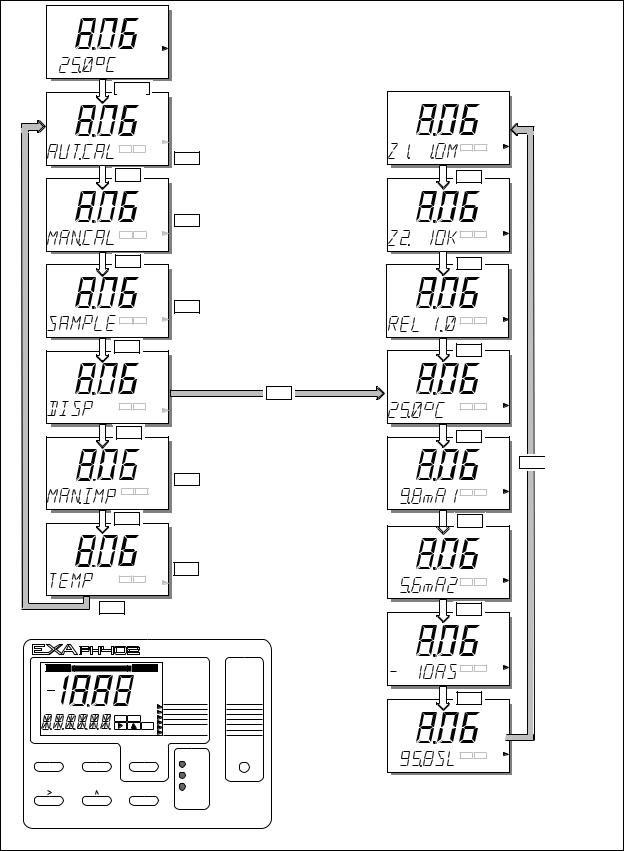
4-4 Operation
4-5. Display functions
4-5-1. Display functions pH (default)
pH
MEASURE
AUT.CAL
MAN.CAL
DISPLAY
TEMP.
HOLD
MODE |
Display Access |
pH |
|
|
|
|
|
Impedance of input 1 |
pH |
|
|
|
|
AUT.CAL |
|
|
|
|
|
|
YES |
NO |
|
|
|
|
YES |
NO |
|
|
|
YES |
(See Auto |
|
|
|
|
|
NO |
|
|
calibration |
|
NO |
|
|
|
|
|
Chapter 6) |
|
|
|||
pH |
|
|
|
|
|
Impedance of input 2 |
pH |
|
|
|
|
YES |
(See Manual |
|
|
|
|
|
YES |
NO |
MAN.CAL |
calibration |
|
YES |
NO |
|
|
|
Chapter 6) |
|
|||||
|
|
|
|
|
|
|
||
|
NO |
|
|
|
|
|
NO |
|
pH |
|
|
|
|
Software release number |
pH |
|
|
|
|
|
YES (See Sample |
|
|
|
||
|
YES |
NO |
MAN.CAL |
calibration |
|
YES |
NO |
|
|
|
|
|
Chapter 6) |
|
|
|
|
|
NO |
|
|
|
|
|
NO |
|
|
|
|
|
|
|
|
|
|
pH |
|
|
|
|
|
Process temperature |
pH |
|
|
|
|
|
|
|
YES |
|
|
|
YES |
NO |
DISPLAY |
|
|
|
YES |
NO |
|
|
|
|
|
|
|
|
|
|
NO |
|
|
|
|
NO |
|
|
|
|
|
|
|
|
|
|
|
pH |
|
|
|
|
|
Current output 1 |
pH |
|
|
|
|
YES (See Manual |
|
|
|
||
|
YES |
NO |
|
Impedance |
|
YES |
NO |
|
|
|
|
|
check Chapter 5) |
|
|
||
|
NO |
|
|
|
|
|
NO |
|
pH |
|
|
|
|
|
Current output 2 |
pH |
|
|
|
|
|
|
|
|
||
|
|
|
YES |
(See Temp |
|
|
|
|
|
YES |
NO |
TEMP. |
menu |
|
|
YES |
NO |
|
|
|
|
Chapter 5) |
|
|
|
|
|
NO |
|
|
|
|
|
NO |
|
|
|
|
|
|
|
Offset |
pH |
|
|
|
|
|
|
|
(as. pot. or |
|
|
|
|
|
|
|
|
zero point) |
|
|
HOLD |
TEMP.MAN. |
FAIL |
MODE |
|
|
|
YES |
NO |
pH |
|
|
|
|
|
|
|
|
mV |
|
|
|
|
|
|
NO |
|
|
|
|
MEASURE |
|
|
|
|
|
|
|
|
AUT.CAL |
|
SETPOINTS |
|
|
|
|
YES NO |
MAN.CAL |
|
RANGE |
Efficiency |
pH |
|
|
|
DISPLAY |
|
SET HOLD |
|
||||
|
|
ENT |
TEMPERATURE |
WASH |
(slope) |
|
|
|
|
|
|
HOLD |
|
SERVICE |
|
|
|
YES |
NO |
MODE |
CONTACTS |
|
* |
Press YES to fix |
YES |
NO |
|
|
|||||||
|
|
|
S1 |
|
the selected second |
|
|
|
|
|
|
S2 |
|
|
line of display |
|
|
WASH/S3
ENT
 FAIL/S4
FAIL/S4
DISPLAY
DISPLAY
DISPLAY
DISPLAY
NO 

DISPLAY
DISPLAY
DISPLAY
DISPLAY
YOKOGAWA
IM 12B6B3-E-E
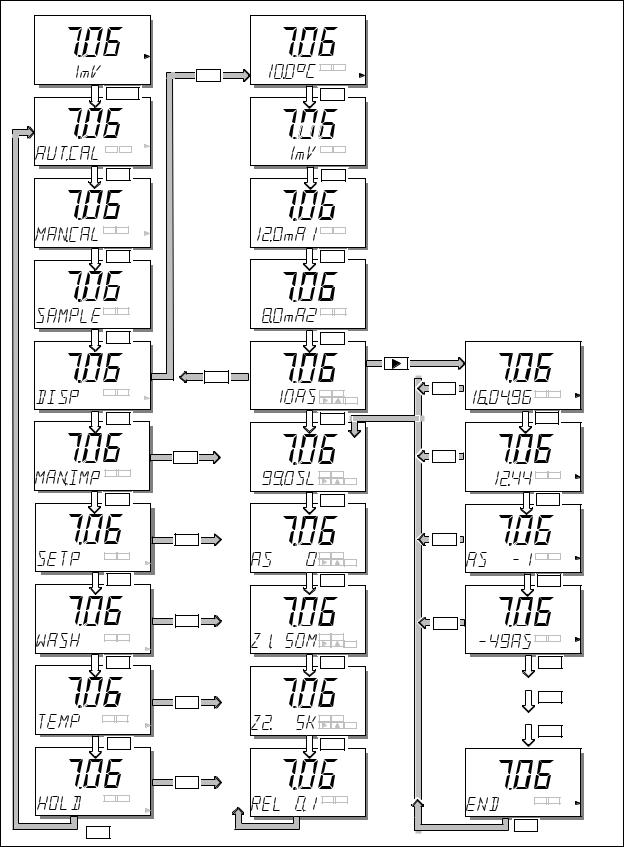
Operation 4-5
4-5-2. Display functions pH (ORP)
|
|
|
Service Code 01 Set for pH. |
pH |
|
pH |
Service Code 02 Set for ORP |
|
on parameter 2. |
||
|
|
|
|
MEASURE |
|
|
|
AUT.CAL |
|
|
|
MAN.CAL |
|
|
YES NO |
DISPLAY |
YES |
|
DISPLAY |
TEMP. |
|
||
HOLD |
|
|
|
MODE |
|
NO |
|
|||
pH |
|
|
pH |
|
|
|
|
|
AUT.CAL |
|
|
"Logbook Scrolling" |
|
YES |
NO |
YES |
NO |
The display can give information |
||
|
||||||
|
|
|
|
DISPLAY |
||
|
|
|
|
|
about calibrations performed |
|
NO |
|
NO |
with date and time. |
|||
|
|
|
|
|
The example below shows |
|
pH |
|
|
pH |
|
Asymmetry Potential. |
|
|
|
|
|
|||
|
|
|
|
|
Scrolling of Data is also |
|
YES |
NO |
|
YES |
NO |
available on Slope. |
|
MAN.CAL |
As Pot ORP |
|||||
|
|
|
|
|||
|
|
|
|
DISPLAY |
Impedance Input 1 |
|
|
|
|
|
|
||
NO |
|
NO |
Impedance Input 2 |
|||
|
When these functions |
|||||
|
|
|
|
|
||
pH |
|
|
pH |
|
are enabled in Service |
|
|
|
|
Codes. |
|||
|
|
|
|
|
||
YES |
NO |
|
YES |
NO |
|
|
|
|
|
|
DISPLAY |
|
|
NO |
Measuring |
NO |
|
|||
|
|
|
|
|
||
pH |
|
Mode |
pH |
|
pH |
|
|
YES |
|
|
|
|
|
YES NO |
As Pot |
YES NO |
|
NO |
NO |
|
DISPLAY |
|
YES |
DISPLAY |
|||
|
|
|
||||
|
Display 2 |
ENT |
DISPLAY |
DATE |
|
|
|
|
|
|
|
NO |
See Man. |
NO |
|
YES |
|
|||
|
|
|
|
|
|
|
|
|
pH |
|
Imp. Check |
|
|
|
pH |
|
|
|
chapter 5 |
pH |
|
|
|
|
||
|
|
YES |
|
|
|
NO |
|
|
YES |
NO |
|
YES |
NO |
|
YES |
NO |
DISPLAY |
|
|
|
|
|||||
|
|
|
|
ENT |
|
|
|
|
|
|
|
|
DISPLAY |
TIME |
|
|
|
|
|
|
|
|
|
|
|
|
NO |
See Setpoint |
NO |
|
YES |
|
|||
|
|
|
|
|
|
|
|
|
pH |
|
Menu |
|
|
|
|
|
|
|
chapter 5.5 |
pH |
|
|
pH |
|
|
|
|
|
YES |
|
|
|
NO |
|
|
YES |
NO |
|
YES |
NO |
|
YES |
NO |
DISPLAY |
|
TEMP. |
|
|
ENT |
DISPLAY |
CAL -1 |
|
|
|
|
|
|
|
|
|
|
|
NO |
See Wash |
NO |
|
YES |
|
|||
|
|
|
|
|
|
|
|
|
pH |
|
Menu |
pH |
|
|
pH |
|
|
|
chapter 5.4 |
|
|
|
|
|||
|
|
YES |
|
|
|
NO |
|
|
YES |
NO |
|
YES |
NO |
|
YES |
NO |
DISPLAY |
|
|
|
|
ENT |
DISPLAY |
VALUE |
|
|
|
HOLD |
|
|
|
|
|
|
|
NO |
See Temp |
NO |
|
YES |
|
|||
|
|
|
|
|
|
|
|
|
pH |
|
Menu |
pH |
|
|
|
|
|
|
chapter 5 |
|
|
|
|
|
||
|
|
|
|
|
YES |
|
||
|
|
YES |
|
|
|
|
||
|
|
|
|
|
|
|
|
|
YES |
NO |
|
YES |
NO |
|
|
|
|
|
TEMP. |
|
|
ENT |
DISPLAY |
YES |
|
|
|
|
|
|
|
|
|
||
NO |
See Hold |
NO |
|
|
|
|
||
|
|
|
|
|
|
|
|
|
pH |
|
Menu |
pH |
|
|
pH |
|
|
|
chapter 5 |
|
|
|
|
|||
|
|
|
|
|
|
|
|
|
|
|
YES |
|
|
|
|
|
|
YES |
NO |
|
YES |
NO |
|
YES |
NO |
|
|
|
Back to |
|
DISPLAY |
||||
|
HOLD |
|
|
DISPLAY |
|
|
||
|
|
|
|
|
|
|||
|
|
the Top |
|
|
|
YES |
|
|
NO |
|
|
|
|
|
|
|
|
|
|
|
|
|
|
|
|
|
IM 12B6B3-E-E
